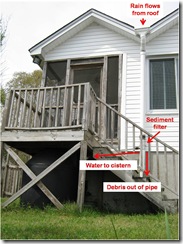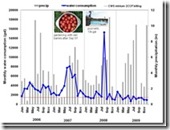Water 101: Seeing clearly after the rain
As evident in the 50 Ways to Save Water report by the SC State Climatology Office, water conservation really is a lot more about common sense than it is rocket science.
Although gadgets exist that can ensure that you consume less water when you do open up a faucet or spigot, the original low-flow control mechanism is your own hand. Don’t leave the water running when it doesn’t need to be running, and don’t open the faucet or spigot up to max flow rate unless it needs to be at max flow rate. Simply turning down the flow rate, especially in the shower, has tremendously reduced my water consumption. Of course, when it is time to replace a leaky faucet or a washing machine (be it clothes or dish washing), it is important to give equal consideration to the resource impact (water and energy used) of the new item as it is to consider the purchase price.
 The Climatology Office water conservation guide also does a nice job pointing out how gray water can be captured and re-used for other purposes like landscaping rather than letting it run down the drain. Notably absent from the water conservation guide, however, is any mention of rain water catchment systems. Being the proud owner of a system that was featured in Charleston Magazine, I can attest to how much municipal water can be saved with these simplistic systems consisting of a downspout, a sediment filter and a rain water collection container; in my case, the four downspouts are also plumbed to a central pump that feeds three outdoor spigots).
The Climatology Office water conservation guide also does a nice job pointing out how gray water can be captured and re-used for other purposes like landscaping rather than letting it run down the drain. Notably absent from the water conservation guide, however, is any mention of rain water catchment systems. Being the proud owner of a system that was featured in Charleston Magazine, I can attest to how much municipal water can be saved with these simplistic systems consisting of a downspout, a sediment filter and a rain water collection container; in my case, the four downspouts are also plumbed to a central pump that feeds three outdoor spigots).
Because 85% of the water consumed in SC annually is derived from precipitation, rain barrels don’t actually reduce the amount of water consumed, but rather they reduce the amount of water consumed from a middle man (i.e., the municipal water supply). However, rain barrels are also commendable because they capture water that may have otherwise assisted in transporting pollutants from impervious surfaces into our atmosphere and local waterways. While theoretically we would want rain water to filter through the soil and re-charge aquifers, in reality 71% of the annual precipitation that reaches the ground ultimately evaporates and the rest works its way towards the ocean (where locally it is skimmed off the surface of the Stono River for our municipal water supply).
Rain barrels are remarkably efficient at capturing rain water, too. Given that a cubic foot of space can hold 7.48 gallons, a one inch rainfall on a square foot of roof perimeter equals 0.62 gal of water. Thus, a rain barrel system constructed to collect 100% of rain that fell on the roof of a home with a building footprint of 1000 ft2 would collect 620 gal of rain with every 1” rainfall. Despite variable precipitation levels, in a typical year in SC rain water collected directly at a home could supply most if not all of the water needs for that home without robbing the runoff destined for the municipal water supply (i.e., after it runs into the storm drains, into the marsh and tidal creeks and eventually the rivers).
So why aren’t rain barrel systems more common? For starters, they’re expensive to install despite their simplicity. My rain barrel system cost over $4500, over half of which was associated with labor charges. And that was just the basic system setup charge; additional filtration (and costs) would be needed to allow my rain water system to be plumbed into my city water lines. However, provided that the City of Charleston would even authorize me to connect a rainwater system to the City lines in my home (which could be safely accomplished with backflow preventers and pressured lines), there is currently no economic incentive for me to do so; we all pay $39/mo for 2 CCFs of water (with a high estimated sewage charge on 90% of that same volume) whether we use the full 2 CCFs or not. And lastly, like any large home appliance, rain barrel systems require regular maintenance ranging from sediment filter cleaning to re-plumbing lines that twist as the rain barrels shift and settle under the weight of the water collected.
 Alas, for now my rain water system is for outdoor use only. Although my investment pay-back time is ~15 years given that my monthly savings only applies to volume conserved >2 CCFs, it is very satisfying to know that in a typical year I’m using upwards to 30,000 gal of water that would’ve otherwise just run down the street and instead I’m diverting it to grow delicious vegetables, fostering nutrient rich compost from mulched (using an electric lawnmower) oak leaves, watering the lawn or replenishing water lost to evaporation in the pool and hot tub…now that’s mainstream sustainability!
Alas, for now my rain water system is for outdoor use only. Although my investment pay-back time is ~15 years given that my monthly savings only applies to volume conserved >2 CCFs, it is very satisfying to know that in a typical year I’m using upwards to 30,000 gal of water that would’ve otherwise just run down the street and instead I’m diverting it to grow delicious vegetables, fostering nutrient rich compost from mulched (using an electric lawnmower) oak leaves, watering the lawn or replenishing water lost to evaporation in the pool and hot tub…now that’s mainstream sustainability!
